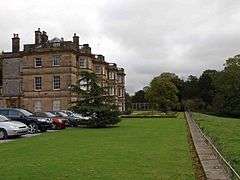Hassop Hall
Hassop Hall is a 17th-century country house near Bakewell, Derbyshire, which was operated as a hotel until it closed on 29 September 2019.[1] It is a Grade II* listed building.[2]
| Hassop Hall | |
|---|---|
 Hassop Hall in 2008 | |

| |
| General information | |
| Town or city | Bakewell |
| Country | England |
| Coordinates | 53.2468°N 1.6689°W |
| Construction started | 17th century |
History
The Manor was owned by the Foljambe family until the 14th century when it passed by the marriage of Alice Foljambe to Sir Robert Plumpton. His son Sir William Plumpton served as High Sheriff of Derbyshire in 1453. The Plumptons sold the estate in 1498 to Catherine Eyre.
The manor house was substantially rebuilt in the early 17th century by Thomas Eyre. During this period the Eyres were strongly Royalist and during the Civil War the family allowed the Hall to be garrisoned by the King's Army. In 1646 the estate was sequestered by the Commonwealth and Rowland Eyre was obliged to compound at a cost of £21,000 for its return.[3]
The house was rebuilt in about 1774.[2] In 1814 it was inherited by Francis Eyre,[4] who had wrongly claimed the title of 6th Earl of Newburgh. The claim to the earldom was based upon the marriage of Francis Eyre (d. 1804) to Mary Radclyffe,[5] daughter of Charles Radclyffe, 5th Earl of Derwentwater, (3rd son of Edward Radclyffe, 2nd Earl of Derwentwater) and Charlotte Maria Livingstone, 3rd Countess of Newburgh.[6] Although Mary's brother and his son had succeeded as 4th and 5th Earl of Newburgh, Mary's claim (and therefore that of Francis) ultimately proved subordinate to that of a daughter by an earlier marriage.
In 1816–17 Francis Eyre built a Roman Catholic chapel, Church of All Saints, Hassop, next to the entrance lodge of the hall; the design, by Joseph Ireland, was based on that of Inigo Jones' St Paul's Covent Garden. The building was later transferred to the Diocese of Nottingham.[4] From 1827 Eyre altered the house itself considerably, creating a substantial mansion with a south front of three storeys and seven bays alternately canted to full height,[2] and a pedimented Tuscan order doorway.
In 1833 Mary Dorothea Eyre, who married Charles Leslie, inherited the Hassop estate. In 1919 the Leslie family sold it to Sir Henry Stephenson. The Stephenson family sold the house and grounds in 1975 to Thomas Chapman, who converted it into an hotel.[7] Thomas Chapman's sons, Richard and Tom, ran the hotel in later years, keeping up its famously high standards. The hall was sold to care home owner John Hill and his wife Alex,[8] and returned to private residential use in 2019.[1]
References
| Wikimedia Commons has media related to Hassop Hall. |
- Bokros, Tom (31 March 2019). "Famous Derbyshire country house hotel announces closure". Derby Telegraph. ISSN 0307-1235. Retrieved 6 October 2019.
- Historic England. "Hassop Hall (Grade II*) (1088171)". National Heritage List for England. Retrieved 22 April 2015.
- Old Halls, Manors and Families of Derbyshire Volume I Hassop Hall. Joseph Tilley From Genuki
- "All Saints Bakewell Road, Hassop, Derbyshire" (PDF). Nottingham Diocese. Retrieved 8 May 2013.
- Lundy, Darryl. "Lady Maria Francesca Giulielma Radclyffe". thepeerage.com.
- Lundy, Darryl. "Charlotte Maria Livingston, Countess of Newburgh". thepeerage.com.
- Hassop Hall Hotel website with history
- "Hassop Hall Hotel". Another helping from Martin Dawes. Retrieved 2019-10-06.